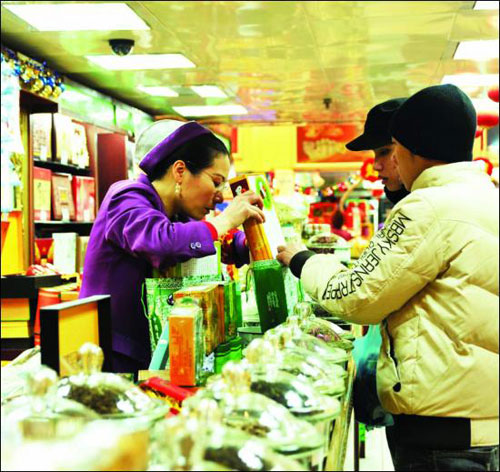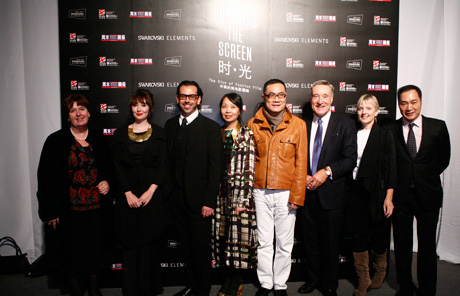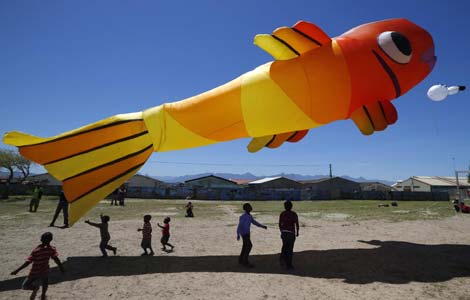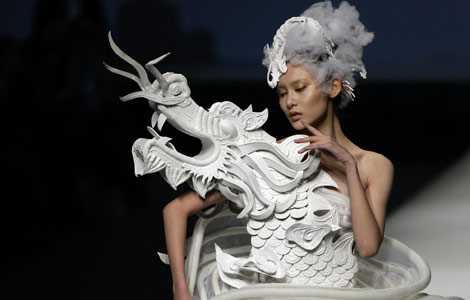The Tao of tea
Updated: 2012-11-02 10:49
By Sudeshna Sarkar, Ben Yue (China Daily HK Edition)
|
||||||||
Sebastian Beckwith sips his tea appreciatively while listening to the strains of the flute playing a popular love song. His cup is replenished by a smiling, soft-footed waiter in traditional Chinese loose cotton trousers and a high-necked shirt with long sleeves.
The American tea merchant travels all over the globe looking for teas he can buy and sell. In Hong Kong, his search has led him to LokCha, a place with character, located in Hong Kong Park, next to the Museum of Tea Ware.
Started in 1991 to sell fine tea blends to connoisseurs directly from farmers on the Chinese mainland, LokCha has grown from a small tea retail shop into a center promoting Chinese tea and culture under its founder Ip Wing-chi. In addition to selling tea and tea ware, it now holds tea appreciation classes and on weekends, Cantonese and Mandarin opera to accompany the flavorful tea served.
 |
|
Customers buying tea leaves at a supermarket in Beijing. Green tea still dominates China although the domestic consumption of red tea is growing quickly. [Photo/Agencies] |
"Tea is a kind of art," says the 61-year-old Ip, a Fine Arts graduate who plays host at the soirees, introducing musicians and keeping up a flow of conversation. "It is culture, lifestyle and philosophy as well."
Far from Hong Kong Park, in Wenzhou city, Zhejiang province, LokCha has soulmates.
In Tong Jia Qiao Road and Xue Yuan Road, there are two tea shops offering customers a taste of fine tea and culture. Only, the culture they promote is Indian.
The walls in Premier's Tea Houses in Wenzhou display posters and photographs of famed tea gardens and landmarks in India, such as the Victoria Memorial in Kolkata. Wood and stone elephants carved in the traditional Indian style greet customers with soft classical Indian music playing in the background.
"The Premier's Tea Houses are the first (of their kind) in Wenzhou," says Eric Yee, Hong Kong resident director of the Indian tea company.
Premier's Tea exports to countries like Canada, Britain, Germany, France, Japan and South Korea. H.A. Shah, its founder and managing director, says the brand has been so successful that when Luxasia Singapore, distributor for "Jennifer Lopez" and "Bvlgari" perfumes, launched a new product in 2003, it selected Premier's teas as give-away gifts during the event.
"Our tea houses not only promote tea, they promote the Indian culture," says Yee. "We opened the Wenzhou tea houses this year and a Shanghai store will open soon. We also plan to develop the tea shop concept in Hangzhou, Beijing, Shenzhen and Guangzhou. Our aim is to build up the Premier's brand in China and open shops in first-tier Chinese cities in three to four years."
In Shanghai, 30-year-old Charles Luo is making plans for his Shanghai NauTical International Trading, a two-year-old company that sells tea produced by Euro Asia Corporation, an upcoming company from Sri Lanka, the largest tea exporter in Asia and the second largest in the world.
After establishing Euro Asia's brands in China, Luo says he would like to expand to Australia.
The shape of things is quite clear. Despite conceding its position as the largest tea exporter in the world, China is still a major force. Indeed, its role has widened now with other dominant tea producing countries in Asia seeking cooperation with the Middle Kingdom.
Wu Xiduan, a prominent tea merchant and former general secretary of China Tea Marketing Association, highlights the new trend in the tea industry in Asia — joint ventures or collaborations with tea producers seeking to do business with China and in China.
Asian tea's traditional markets in the Middle East have been hit by the political flux there and those in Europe and the US are struggling with a sluggish economy.
"Some traditional tea planting countries, such as India and Sri Lanka, have begun to set up business in China, targeting the growing red tea market in China," Wu says. "Although green tea still dominates China, the domestic consumption of red tea is growing fast.
"In 2005, only about 25 percent of the red tea produced in China sold domestically. But last year domestic consumption grew to 78,000 tons, six times higher than in 2005."
One of the biggest joint ventures in China is between Zhejiang Tea Import and Export — the largest green tea exporter in the world with a wide marketing network in Japan, Pakistan, Morocco and other African countries — and Tata Tea, one of the biggest branded tea players in India.
In 2007, the two signed an agreement to set up a joint venture at the economic development zone of Anji county, Zhejiang, for manufacturing and marketing green tea polyphenols, other green tea extracts, cold and hot water soluble instant tea, liquid tea concentrates and other beverage products.
Tata Tea said it would own 70 percent of the registered capital of the joint venture at an estimated project cost of Rs 700 million ($13.4 million), to be funded by a mix of equity capital and borrowings.
The joint venture would help the Indian company, which mostly sells black tea, to gain a larger foothold in the tea extract market by diversifying into green tea.
In 2011, Wu says, China produced 1.4 million tons of tea, which included black, green and other varieties of tea. While 1 million ton was consumed domestically, 300,000 tons was meant for export and the rest was made into value-added products, such as soft drinks, tea-flavored food and instant tea. The Chinese tea industry, he says, had been too scattered for a long time.
"Most tea farms are family-size and not using production methods (to get optimum growth)," Wu says. "The strongest brands' annual sale is only around 1.5 billion yuan ($237 million)."
Also, the rising labor cost and exchange rates have affected the industry, causing a price hike. However, many new tea plantations have started coming up.
"These farms will begin producing in three years, and their output will mature in five years," Wu says. The new output is likely to change the face of the market.
Meanwhile, exports have been rising steadily. In 2011, Wu says exports rose 6.6 percent year on year while sales realized $965 million, up 23.1 percent year on year.
Besides the rise of red tea in China, with green tea catching on in other countries, and cross-border collaborations to promote both, Chinese tea is carving out a niche for itself. One of the best known examples of specialized teas China offers is Panda tea, the variety grown in the mountains of Ya'an, Sichuan, fertilized with panda dung and fetching a high price.
"These elite, expensive teas are mostly bought as presents by those looking for super premium products to gift," says LokCha's Ip.
Then there is Sichuan's Oolong tea, Yunnan's Puer tea, and a host of other rare premium teas.
The Anhua Yiqingyuan Tea Industry company in Hunan makes one of these rare types — the Qiang Liang tea. The name literally means 1,000 Chinese ounces, and the black tea is sold in little rolls 1.5 meter long with a 20 cm diameter, weighing 36.25 kg.
Li Jian, public relations manager of the five-year-old company, says Qiang Liang tea is handcrafted through 80 procedures and is listed as an intangible cultural heritage.
"The tea is grown in the company's own garden in Anhua, Hunan," Li says. "It is expensive — one roll costs 4,180 yuan — because of its limited production. Qiang Liang tea can only be made during three months a year, from July to September, and all the procedures are done by hand."
Anhua Yiqingyuan Tea Industry had an annual sale of 200 million yuan. About 40 to 50 percent of the product is exported. Qiang Liang tea is believed to be good for digestion and for lowering high blood pressure.
"Our domestic clients are people in their 40s (and above) who are conscious of their health," Li says. "Our foreign clients are mainly in Europe and North America."
Russia is a major market and the company has a website in Russian as well.
A tea that was once consumed only in China is now spreading worldwide.
"Through the 2012 China-Arab States Economic and Trade Forum, which was held in the Ningxia Hui Autonomous Region in September, we now have clients in the Middle East and Central Asia who traditionally eat a lot of meat and dairy products that need digestive aids," Li says.
He foresees a bright future for Chinese teas.
"Black tea will be the next star in the market," Li predicts. "Our domestic sale tripled last year."
The writers can be contacted at sarkar@chinadailyapac.com and benyue@chinadailyhk.com











